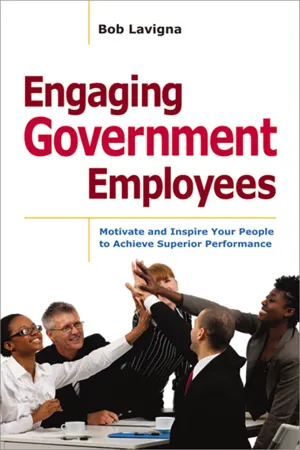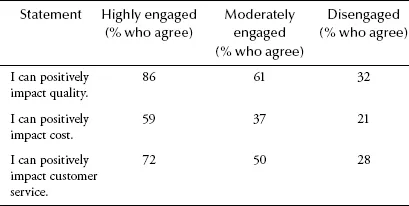CHAPTER 1
______________
The Power of Employee Engagement and What This Book Is About
This is not an easy time to be employed in the public sector. Heated budget battles and rhetoric about the size, function, scope, and effectiveness of government have generated criticism not just of government but also of the public servants who deliver government services. Across the country—in Congress, state legislatures, city councils, political speeches and ads, the media, and elsewhere—government organizations and their employees are denigrated and stigmatized as underworked and overpaid.
In stark contrast, in the not-too-distant past, government service was a respected profession—described as a “noble calling” by President George H. W. Bush.1 The best and brightest across our nation aspired to make a difference by devoting their careers to public service, whether it was in Washington, DC, crafting national policies, or in their local communities, protecting their neighbors, teaching their children, or helping in countless other ways.
Sadly, opinion has changed, and the public no longer views government as a noble calling.
Here’s how Jay Leno described the work of government: “A survey says that American workers work the first three hours every day just to pay their taxes. So that’s why we can’t get anything done in the morning: We’re government workers.”2
Writer and philosopher Alex Pattakos, a strong proponent of the public service, has cited this cynical joke: “Why doesn’t the civil servant look out her window in the morning? Answer: So she’ll have something to do in the afternoon.”3
And so on.
Those who criticize government, and the people who work in government, have lost sight of the critically important work of the public sector. This work affects everyone—nationally, in our states, and in our local communities. At the same time government is being castigated and hamstrung by budget cuts, the public continues to ask the public sector to solve some of the toughest and most intractable problems: fixing the economy, putting people back to work, supporting a war that has stubbornly persisted for a decade, protecting the public, maintaining the quality of life in our communities, eliminating poverty, expanding opportunity by improving the education system, providing affordable health care, and so on.
And, as we tragically learned in the aftermath of Hurricane Katrina, when government fails, people can die.
This paradox—attacking public servants while at the same time expecting them to solve problems no other sector can handle—places government leaders and managers squarely in the middle of an extremely difficult situation. Those who lead the 18,000,000-strong public-sector workforce, the nation’s largest, must somehow find ways to motivate their employees despite harsh public criticism and shrinking resources.
How can these public-sector leaders, from senior-level executives to frontline supervisors, meet this challenge?
One proven solution is to improve the level of employee engagement in their organizations and agencies. After all, the primary resource we have in government is our talent—our people. If they perform well, government performs well.
But what is employee engagement and why does it matter? The concept has been around for decades but has come into much greater focus in the past decade. One particularly useful and actionable definition characterizes engagement as a heightened employee connection to work, the organization, the mission, or coworkers. Engaged employees find personal meaning and pride in their work. They believe that their organizations value them, and in return, engaged employees are more likely to go above the minimum and expend “discretionary effort” to deliver performance.4 The consulting firm BlessingWhite sums it up even more succinctly: “Engaged employees plan to stay for what they give, disengaged stay for what they get.”5
There is strong research-based evidence for why managers should care about employee engagement. Simply put, organizations with engaged employees outperform organizations whose employees are not engaged. This is true in both the public and private sectors.
For example, the Gallup organization, best known for its public-opinion polling, has also systematically studied employee engagement by analyzing engagement surveys of millions of employees. Gallup’s research reveals that high-engagement organizations outperform low-engagement organizations in seven critical areas: profitability, productivity, customer satisfaction, retention, absenteeism, safety, and lost or stolen inventory. According to Gallup, high-engagement organizations are almost 20 percent more productive than their low-engagement counterparts.6
But how do these results translate to government, which usually doesn’t rely on measures like profitability? The Gallup research shows that improved engagement drives outcomes that are also important in government, like productivity, customer satisfaction, and retention. Think about what a 20 percent improvement in productivity would do for your organization, jurisdiction, agency, or work unit.
Even more specific to the public sector, the U.S. Merit Systems Protection Board (MSPB) studied survey results from 37,000 federal government employees. The board found that higher levels of employee engagement across the federal government correlated with
• higher rates of success achieving strategic goals;
• higher employee retention;
• fewer days of sick leave and less lost time due to work-related injury or illness; and
• fewer equal employment opportunity complaints.7
A TowersWatson Consulting survey of more than 17,000 public and nonprofit employees revealed that highly engaged employees scored dramatically higher on key survey questions/statements, compared to moderately engaged and disengaged employees (Table 1.1).8
This and other research clearly show that employee engagement can be a powerful force for organizational change and effectiveness. Given the challenges public-sector managers face trying to succeed despite public criticism, budget cuts, layoffs, and reductions in employee compensation and benefits, building and maintaining employee engagement is more important than ever. It is also more difficult to achieve.
This book is about how to meet this challenge—by measuring employee engagement, analyzing the results of these measurements, using the data to take systematic action to improve engagement, and then sustaining it over time in government—the nation’s largest and perhaps most important employer.
There are many other books about employee engagement, and some are excellent. But this book departs from the others in three ways.
Table 1.1. Results From the TowersWatson Consulting Employee Engagement Survey
First, I focus on the science of employee engagement—that is, what the research clearly proves about the power of engagement to improve individual and organizational performance. Instead of relying on my insights “culled from my many years of experience” or “my work with many different types of organizations,” I emphasize what the engagement research has proven empirically and how these results apply to government organizations.
Sure, I have experience with engagement, and I will cite some of these experiences as examples, but I don’t trust purely anecdotal experiences and don’t believe they necessarily apply to the situations or challenges other managers face. I don’t rely exclusively on my personal experiences to make the case for why government leaders, managers, frontline supervisors, and employees should focus on engagement. Instead, I rely on the research and empirical evidence.
Second, my focus is government. There are other fine works on the science of engagement, but they don’t emphasize the public sector. In Chapter 4, I highlight the unique challenges government faces, the fundamental differences between the public and private sectors, and the implications of these differences for managers—and for employee engagement. I argue that, in some respects, these differences make it harder to manage in the public sector. As a result, public-sector leaders, managers, and frontline supervisors must approach engagement differently than their private-sector counterparts.
In addition to the hostile environment the government operates in today, other key factors that distinguish the public sector from the private sector include political leadership that changes frequently; hard-to-measure goals and impacts; complicated, rulebound, and sometimes irrational decision making; multiple external stakeholders with power and influence; an older, more educated, and more white-collar workforce; strong civil-service rules and employee protections; heavy union influence; limited financial tools to influence and reward employee behavior; public visibility of government actions; and, more positively, a workforce that is intrinsically motivated toward public service. I believe that government leaders and managers need to understand these differences and their implications for employee engagement. This argument is a key focus of this book.
The third way in which this book departs from many other works on engagement is that I don’t present a one-size-fits-all approach to improving engagement. There are many engagement models and approaches that their designers maintain can be adopted just about anywhere. In contrast, I don’t see how any single employee-engagement model can apply to all organizations and situations, particularly in government. Just in the United States, there are more than 85,000 government jurisdictions and agencies, and each has its own mission, strategy, values, and culture.
Instead, I believe that every organization needs to measure its own level of employee engagement, analyze the results to identify specific areas to improve, set priorities for action, and then act on the data. While there are some broad principles that apply generally to engagement (which I’ll discuss), there is no single solution that will automatically improve engagement across all organizations.
I do present a model in Chapter 7, but it is an engagement process model—that is, a model that a public-sector organization can adapt and adopt to assess its level of employee engagement. The organization needs to then act on these results to improve engagement. The model is intended to help each agency generate the data it needs to draw conclusions about what its employee-engagement issues are and how to deal with them to improve engagement, but it does not prescribe generic solutions. In Chapter 12, I describe what some government agencies have done to improve engagement, but I present these actions as examples, not prescriptions.
From the start, it is important to understand that there is no silver bullet to achieve high levels of employee engagement. Instead, what’s needed is silver buckshot—an integrated series of actions, specific to each government jurisdiction or agency, to measure and then improve engagement.
Here’s a quote that I think sums up the power of employee engagement. According to Jim Goodnight, CEO of SAS, a leading business software company that is also a perennial member of Fortune magazine’s annual “100 Best Companies to Work For,” “My chief assets drive out the gate every day. My job is to make sure they come back.”9
Goodnight’s statement is just as applicable (or maybe even more applicable) to government. And improving engagement is one clearly documented way to make sure that when the chief assets of government leave at the end of the day, they do plan to return tomorrow.

